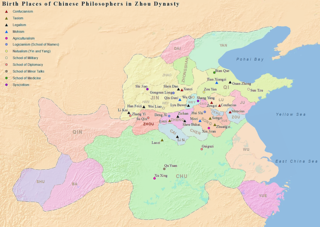
Traditional Chinese medicine (TCM) is an alternative medical practice drawn from traditional medicine in China. It has been described as "fraught with pseudoscience", with the majority of its treatments having no logical mechanism of action.

Yin and yang, also yinyang or yin-yang, is a concept that originated in Chinese philosophy, describing opposite but interconnected, mutually perpetuating forces. The technology of Yin and yang is the foundation of critical and deductive reasoning for effective differential diagnosis of disease and illnesses within Confucian influenced traditional Chinese medicine.
The zangfu organs are functional entities stipulated by traditional Chinese medicine (TCM). These classifications are not based in physiology or science. They constitute the technological centrepiece of TCM's general concept of how the human body works. The term zang refers to the organs considered to be "solid" yin in nature – Heart, Liver, Spleen, Lung, Kidney – while fu refers to the "hollow" yang organs – Small Intestine, Large Intestine, Gall Bladder, Urinary Bladder, Stomach and San Jiao.
The model of the body in traditional Chinese medicine (TCM) has the following elements:
In traditional Chinese medicine the Small Intestine is a fu organ in the Zang-fu concept.
The Spleen is one of the zàng organs stipulated by traditional Chinese medicine (TCM). It is a functionally defined entity and not equivalent to the anatomical organ of the same name.
The lungs is one of the zang organs described in traditional Chinese medicine. It is a functionally-defined entity and not equivalent to the anatomical organ of the same name.
The large intestine is one of the fu organs stipulated by traditional Chinese medicine (TCM). As distinct from the Western medical concept of large intestine, this concept from TCM is more a way of describing a set of interrelated parts than an anatomical organ. It is a functionally defined entity and not equivalent to the anatomical organ of the same name.

Zhang Zai (1020–1077) was a Chinese philosopher and politician. He is most known for laying out four ontological goals for intellectuals: to build up the manifestations of Heaven and Earth's spirit, to build up good life for the populace, to develop past sages' endangered scholarship, and to open up eternal peace.
In Traditional Chinese medicine, the Six Levels, Six Stages or Six divisions is a theory used to understand the pathogenesis of a illness through the critical thinking processes of inductive and deductive logic utilising the model of Yin and Yang. This theory originated from Shang Han Lun by Zhang Zhongjing in 220 CE or about 1800 years ago.

Ye Tianshi (1667–1747) was a Chinese medical scholar who was the major proponent of the "school of warm diseases". His major work, Wen-re Lun published in 1746, divided the manifestations of diseases into four stages: wei, qi (qi-phase), ying (nutrient-phase), and xue (blood-phase).

Neidan, or internal alchemy, is an array of esoteric doctrines and physical, mental, and spiritual practices that Taoist initiates use to prolong life and create an immortal spiritual body that would survive after death. Also known as Jindan, inner alchemy combines theories derived from external alchemy, correlative cosmology, the emblems of the Yijing, and medical theory, with techniques of Taoist meditation, daoyin gymnastics, and sexual hygiene.
The Shanghan Lun is a part of Shanghan Zabing Lun (simplified Chinese: 伤寒杂病论; traditional Chinese: 傷寒雜病論; pinyin: Shānghán Zábìng Lùn. It is a Traditional Chinese medicine treatise that was compiled by Zhang Zhongjing sometime before 220 AD, at the end of the Han dynasty. It is amongst the oldest complete clinical textbooks in the world. It is considered one of the four canonical works of Traditional Chinese medicine, along with Huang Di Nei Jing, Jin Gui Yao Lue, and Wen Bing Xue.
Li is a concept found in neo-Confucian Chinese philosophy. It refers to the underlying reason and order of nature as reflected in its organic forms.
Blood stasis (BS) is a concept in traditional Chinese medicine (TCM), described as a slowing or pooling of the blood due to a disruption of heart qi. Blood stasis is also described by practitioners of TCM in terms of yin deficiency, qi deficiency and qi stagnation. For non-practitioners of TCM it is sometimes explained in terms of hematological disorders such as hemorrhage, congestion, thrombosis or local ischemia, and in terms of tissue changes. TCM practitioners believe it is an important underlying pathology of many disease processes despite the fact that objective, consistent methods for measuring the presence of blood stasis syndrome are not readily available. Blood stasis is associated with justifications for acupuncture and herbal treatments.

Dante Lam Chiu-yin is a Hong Kong filmmaker, actor and action choreographer.
In Chinese philosophy, fire Fire is the second phase of Wu Xing.

The School of Naturalists or the School of Yin-Yang was a Warring States-era philosophy that synthesized the concepts of yin-yang and the Five Elements. It was one of the Nine Schools of Thought.

Tongue diagnosis in Chinese Medicine is a method of diagnosing disease and disease patterns by visual inspection of the tongue and its various features. It is one of the major diagnostic methods in Chinese Medicine since the time of the Yellow Emperor's Inner Classic. It is considered a part of the “Inspection” method within the four methods of diagnosis. Practitioners claim that the tongue provides important clues reflecting the conditions of the internal organs. Like other diagnostic methods in Traditional Chinese Medicine, tongue diagnosis is based on the “outer reflects the inner” principle, which is that external structures often reflect the conditions of the internal structures and can give us important indications of internal disharmony.
Zhang Congzheng, courtesy name Zihe, was a Chinese physician and writer active during the Jin dynasty. Based in the capital city of Daliang, Zhang was known for his aggressive and unorthodox approach to medicine, which was based on the belief that all illnesses were caused by "deviant" qi. He is regarded as one of the "Four Great Masters" of the Jin-Yuan period.







